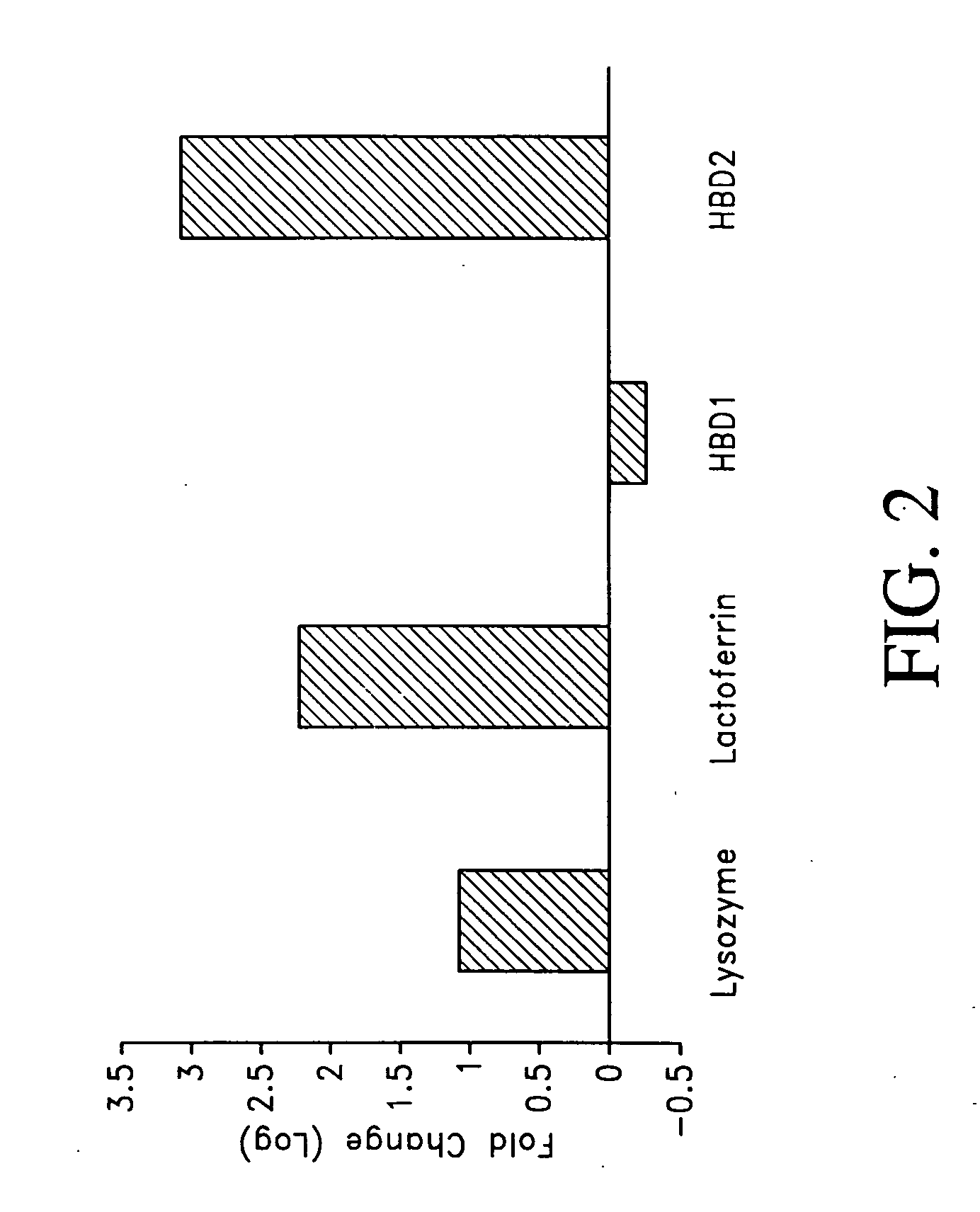Use of antimicrobial proteins and peptides for the treatment of otitis media and paranasal sinusitis
- Summary
- Abstract
- Description
- Claims
- Application Information
AI Technical Summary
Benefits of technology
Problems solved by technology
Method used
Image
Examples
example 1
[0088] Expression of innate immune molecules: Lysozyme, Lactoferrin, and human beta defensins in the middle ear and the middle ear mucosa normally and in response to pathogens
[0089] As shown in FIG. 1, a gel overlay assay was performed to show that experimentally induced effusion in rats contained molecules electrophoretically consistent with the molecules of innate immunity and which had anti-microbial activity. Rats were inoculated with 1.0 mg of S. typhimurium endotoxin in 100 μl of sterile saline. Animals were sacrificed after 48 hours and the effusion was collected. The microbicidal activity of the samples was then evaluated using the gel over-lay assay. The radial assay method of Lehrer and coworkers was used, with minor modifications (Lehrer et al., 1991 J Immunol Methods 137:167-73). The subcultured bacteria (4×106 CFU / 10 ml underlay gel) were mixed with melted underlay gel at 42° C. (0.1× culture broth—BHI for NTHi and Moraxella and THB for S. pneumoniae-10 mM sodium phosp...
example 2
The Effect of Lysozyme, Lactoferrin and Human Beta-Defensins on OM Pathogens
[0093] The radial assay method of Lehrer and coworkers was used, with minor modifications (Lehrer et al., 1991 J Immunol Methods 137:167-73). The subcultured bacteria (4×106 CFU / 10 ml underlay gel) were mixed with melted underlay gel at 42° C. (0.1× culture broth—BHI for NTHi and Moraxella and THB for S. pneumoniae-10 mM sodium phosphate, 0.8% low electroendosmosis (EEO)-type agarose) and poured into 8 cm×8 cm square Petri plates. The gel was allowed to solidify in the Petri plates and wells were punched out with a calibrated 200 μl micropipette tip, cut off at the 50 μl mark (approximately 3 mm). The antimicrobial peptides and proteins were dissolved in 0.01% acetic acid and 4 μl was added to each well. The plates were then incubated for 3 hours at 37° C. in the 5% CO2 incubator. They were next overlaid with the overlay gel (0.5× culture broth, 10 mM sodium phosphate, 0.8% low EEO-type agarose) and covered...
example 3
[0097] A dose response analysis is performed for each molecule in order to determine the concentration range where the best effect is observable as well as a synergistic effect of different combinations. Thus, various concentrations of lactoferrin with various concentrations of defensins are used as in Example 1 and the concentrations at which maximum effectiveness of the combination occurs are used in further treatments.
PUM
| Property | Measurement | Unit |
|---|---|---|
| Digital information | aaaaa | aaaaa |
| Frequency | aaaaa | aaaaa |
Abstract
Description
Claims
Application Information
 Login to View More
Login to View More - R&D
- Intellectual Property
- Life Sciences
- Materials
- Tech Scout
- Unparalleled Data Quality
- Higher Quality Content
- 60% Fewer Hallucinations
Browse by: Latest US Patents, China's latest patents, Technical Efficacy Thesaurus, Application Domain, Technology Topic, Popular Technical Reports.
© 2025 PatSnap. All rights reserved.Legal|Privacy policy|Modern Slavery Act Transparency Statement|Sitemap|About US| Contact US: help@patsnap.com



